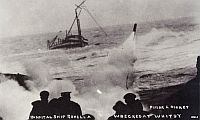 Just over 100 years ago, the World War I hospital ship, SS Rohilla, ran aground in a gale less than a mile off the North Yorkshire coast, near Whitby, with the loss of 85 crew and passengers. SS Rohilla had left Scotland on 30 October 1914 with 229 aboard and had been thrown off course by violent storms. The ship was carrying medical staff bound for Dunkirk, in Belgium, to treat the wounded from the Great War. The rescue, which would take three days, also marked the end of the rowed lifeboat for ship rescue.
Just over 100 years ago, the World War I hospital ship, SS Rohilla, ran aground in a gale less than a mile off the North Yorkshire coast, near Whitby, with the loss of 85 crew and passengers. SS Rohilla had left Scotland on 30 October 1914 with 229 aboard and had been thrown off course by violent storms. The ship was carrying medical staff bound for Dunkirk, in Belgium, to treat the wounded from the Great War. The rescue, which would take three days, also marked the end of the rowed lifeboat for ship rescue.
For three days, brave lifeboat crews from Whitby and surrounding communities battled to reach the stranded ship, which was breaking up under in the storm. After initially rescuing over 90 of the survivors, the conditions worsened, so that the oar-powered lifeboats were unable to reach the remaining survivors aboard the ship. Finally one of the very few motor-driven lifeboats of the day, the Henry Vernon, was brought from Tynemouth, and successfully rescued the last 50 survivors. According the legend, the last off the ship was the captain carrying the ship’s black cat.
The RNLI produced a short documentary about the Rohilla Rescue:
Unlike the US Coast Guard, which is a branch of the military and funded by taxpayers, the RNLI (the Royal National Lifeboat Institution) is a charity. The RNLI operates 444 lifeboats (332 at 236 lifeboat stations, 112 in the relief fleet). Crews rescued on average 23 people a day in 2013. Most lifeboat crew members are unpaid volunteers.
Thanks to Alaric Bond for contributing to this post.

A great story. Years ago we tried (emphasis on tried) to compete with an RNLI crew in the lifeboat races that were held at South Street. Those hardy blokes left us — and everyone else — sucking foam in their wake.